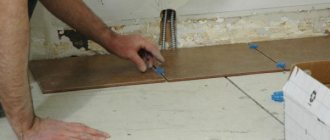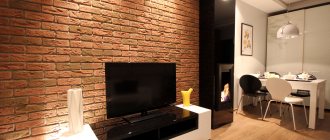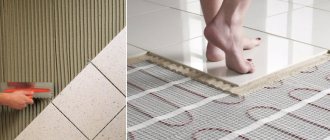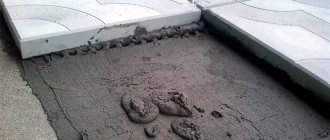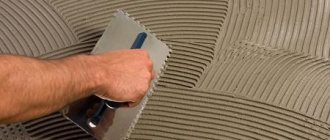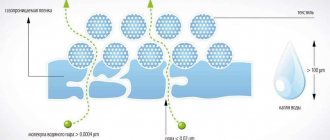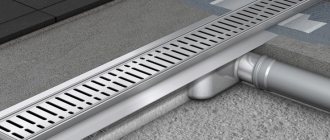Interior design is an actively developing industry, in no small part due to the abundance of finishing materials and accessories. Tiled or ceramic tiles are one of the popular items on the list of things needed for tiling work.
One of the unusual ways is to lay tiles on the floor diagonally. What do you need to know about this?
Laying tiles on the floor diagonally
There is a popular opinion that even a novice decorator can lay out a kitchen “apron” if the walls are straight. Therefore, in addition to choosing and purchasing tiles, the issue of skill in work is important. Let's consider how to choose the right tile depending on the functional purpose, what to look for and what items you can choose in a budget option. Let's look at the known installation methods, their advantages and disadvantages. Let's focus on choosing the necessary consumables. This will help you decide whether to start implementing the project yourself or make a choice in favor of a specialist.
What do you need to know when choosing?
Let's understand the terminology. Ceramic tiles are a product intended for interior and exterior decoration. A mixture consisting of quartz, clay, and other natural components is pressed and fired in special kilns. Tile is one of the varieties of finishing material, for the manufacture of which light grades of clay are used.
Ceramic tiles are included in the list of materials suitable for use in finishing rooms in which people are located. And of course, its properties are strictly regulated by GOST. For example, a standard that contains requirements for the manufacture of ceramic floor tiles. It applies to products that can be used in the decoration of residential and public buildings, including domestic areas in production.
Important! This GOST does not apply to rooms in which the tiles are exposed to concentrated acids and alkalis.
You should choose only high-quality tiles that are resistant to abrasion and fading.
When choosing tiles, you need to pay attention not only to its decorative component. It is necessary to use information about its resistance to external aggressive factors, abrasion, and loss of color. Saving on quality may lead to the need for additional investments.
It was said above that it is worth considering the functional properties of the product - in what room it will be used, on what surface the finishing material is intended.
ceramic tiles
Let's start in order. When choosing a finishing material, you need to pay attention to the following factors.
- The reputation of the retailer where you are going to purchase the product. Even without special knowledge, you can first check the quality of the product. Pay attention to the edges to avoid chipping or damage. Poor-quality enamel is indicated by cracks and coating defects. Comparing several samples should convince you that they match in size (there are requirements for grading), shade, and pattern.
- Functional purpose of the room. For example, if you need material for decorating external walls or floors, you should pay attention to frost-resistant products. These undoubtedly include porcelain stoneware.
You need to consider where exactly you plan to lay the tiles, and based on this, choose the finishing material
Clinker tiles are distinguished by their strength and durability, which is a consequence of the manufacturing process. High-quality clay is fired in special kilns at temperatures over a thousand degrees Celsius. The tiles can withstand low temperatures, direct sunlight, and high humidity.
Important! Even in harsh winters, hot summers and long rainy seasons, the material does not crack or fade.
If you are going to decorate a kitchen, bathroom, toilet, it is better to choose a matte satin glaze. These areas constantly require removal of contamination. Such tiles are easier to care for. Its smooth surface is cleaned faster and better than a rough one.
- Room area. It is better to decorate small rooms with glossy tiles of a light shade. This simple move will visually expand the volume of space. You can combine different colors, provided that the majority of the color is light. For example, a compromise solution is white walls and a dark floor. To enlarge a small space, it is important to choose the right tile size. The decorative strip along the wall should be a definitely lighter shade than the base color.
When choosing tiles, it is important to consider the area of the room.
- Wear resistance of the material. This property determines how much the tile can withstand external influences. This is especially true for floor products. The wear resistance of ceramic tiles characterizes the ability to withstand the load that is generated when a person moves along its surface. Therefore, the characteristic is applicable to glazed products and determines the durability of the top layer of glaze. There are five classes, which are coded using alphanumeric notations. The assessment is based on density, movement activity, and characteristics of the shoes used. Material belonging to class III has universal properties. This product is recommended for areas with moderate traffic where outdoor shoes are not used. Almost all residential premises fall into this category.
Thus, when choosing ceramic tiles, be prepared to evaluate its qualities: the strength of the base and glaze, shades of the same color, resistance to wear, chemicals, humidity, size, possible color solutions.
The strength of the products is also very important.
Materials and tools
Previously, laying tiles on cement mortar was a rather labor-intensive step. Nowadays adhesive mixtures are used for fixation. The range of products is quite wide and to understand it, you need to pay attention to the following.
| Parameter | Meaning |
| Characteristics of the tiles used | Size, surface (matte or glazed), other features. |
| Functional purpose | Outdoor, indoor, high humidity, frost resistance and others. |
| Surface finishing | Walls, floor, steps, fireplace, stove. |
The choice of tiles and adhesives is huge. The best option is to follow the manufacturer’s recommendations for choosing an adhesive base. But there are general principles for selecting composition for various jobs.
The correct choice of tile adhesive is also incredibly important.
The cement-based adhesive composition has not lost its relevance. But it is recommended to use it when fixing small tiles. Most often it is sold as dry mixtures, which you need to prepare yourself. This product position is distinguished by a modest price.
Epoxy adhesive is purchased for laying large tiles in areas with maximum load: industrial workshops, metro, airport. The connection is durable, which does not depend on weather conditions and abrasive action. For domestic use, the disadvantage is the rather high price.
Important! If the composition does not correspond to the chosen purpose, its base is deformed, cracks appear, chips and the tiles fly off.
You can use cement-based or epoxy glue
The choice of glue depends significantly on the substrate on which it will be applied. For example, when laying tiles on a wooden floor, it is recommended to use polyurethane adhesive, which is highly flexible. This is especially important when finishing heated floors.
For interior work, cement-based adhesive is suitable. For exterior finishing they offer a special composition that does not crack and does not lose its properties in cold, heat, or high humidity.
tile adhesive
What else needs to be prepared for work?
Work clothes should protect from dirt, dust, and glue. If necessary, use a respirator and protective gloves. Overalls with pockets are convenient.
It would be a good idea to use a respirator and protective gloves when laying tiles.
The required set of tools includes:
- container for 10-15 liters for solution;
- electric tools (drill, tile cutter), extension cord, pobedit drills;
- spatula, mallet, hammer, chisel, chisel, wire cutters, pliers, knife, tape measure, square, level, construction syringe;
- nails, screws, plastic dowels;
- crosses and spacers;
- chalk;
- grout;
- glue;
- clean damp rags.
Diamond paving of difficult areas
For radial and winding paths, Rhombus paving slabs are not the most suitable option. For example, for the area in the lower diagram, a large number of curly paving elements will need to be trimmed.
At the same time, thanks to the correct geometry and vertical/horizontal symmetry, cutting waste is sharply reduced, since trimmings can be used on the opposite side of the track. But the labor intensity of the work and the consumption of abrasive equipment for angle grinders increases.
Thus, it is preferable to choose Rhombus for paving straight paths, recreation areas and parking lots with the correct geometry. This will reduce the labor intensity of landscaping and work time.
Hexagon
The technique of making a 6-sided or cubic pattern involves joining the obtuse angles of 3 single-color stones at a single point. The result is a pattern that does not need to be emphasized by an outline of a different color.
When the obtuse angles of 3 elements of a single-color tile are joined, a 6-sided tile is obtained, which next to the “Star” layout will look disproportionate. When using a pattern with hexagons, you can achieve a volumetric effect.
Sequence of work
Features of diagonal laying do not affect the sequence of work. But this finishing method requires more consumables. When laying diagonally, the percentage of use of threaded parts increases. To calculate the number of tiles, you need to draw a layout with details to scale.
The difficulty of laying tiles diagonally is that you will need more threaded parts
The easiest way is to count the number of tiles that will be laid as a whole. Then the parts that will be cut in half or more. When counting, each of them is taken as a whole. Depending on the overall pattern of each tile, count the trim pieces. The quantity of tiles required will be 10-15% more than the amount received. Such an allowance will allow you to avoid a shortage of material, even taking into account possible defects and errors made during cutting.
All work is carried out in the following sequence:
- creating a sketch taking into account scale;
- markings on the working surface;
- applying primer;
- applying an adhesive base;
- directly laying ceramic tiles according to the sketch;
- creating a frame, if this is included in the sketch;
- grouting joints.
tile grout
How to choose the right grout mixture
There are different ways to lay ceramic tiles. The basic method is more accessible even for inexperienced workers. It consists of laying out individual elements in even rows. There are methods of bricklaying, herringbone, and carpet patterns.
It is better to purchase the required amount of material + 10-15% - this is important, since an error may occur when cutting or laying
Today we will look at the features of diagonal laying technology.
An obligatory step is leveling the surface (wall, floor) with special tools. If this is not done, the result of long-term labor may be lost after a short time. The tile will lie unevenly, the defect will be visible, and under significant load it may come off.
The markup also has its own peculiarities. On the sketch, which is made in advance, attention is paid to the coincidence of the general pattern. To prevent its distortion, it is imperative to use a level.
Important! Depending on the capabilities, this can be a simple thread or a laser device.
laser level
The diagonal marking is based on a geometric figure - an isosceles triangle with angles of 45°. To determine the first row, lines are drawn horizontally and vertically from the selected starting point. The specified size is laid out according to them.
Before laying tiles, you need to level the surface
The first row can be any row according to the sketch. The choice depends on the complexity of the drawing. Most often they are guided by rows of different colors or shades.
The next rows go up and down from the first.
When finishing work on the wall, the bottom row is supported with a plank so that the pattern does not subsequently “slide” down.
The peculiarity of diagonal masonry is that the pattern must be observed on all four sides of the tile. This leads to increased costs.
The most difficult thing is to follow the pattern when laying
The next step is applying primer. The composition is designed to improve contact between the adhesive and the tile surface. Before applying it, it is necessary to carefully prepare the surface: clean it of debris, wet clean it, and then dry it. If the surface contains traces of grease, treatment with a degreasing compound is required. Depending on the absorbent properties of the wall, the primer is applied once or twice. The exposure time is indicated in the instructions for the primer mixture.
Important! In any case, it is at least an hour after applying the last layer.
Sometimes the primer is replaced with an adhesive composition. There are a number of conditions for this. The wall or floor is pre-plastered. The glue concentration increases. The drying step is skipped. The tiles are immediately laid with glue.
It is necessary to pre-prime the floor
primer
Laying technology
Diagonal laying requires practical experience.
Laying in diamond shapes is done not from the center, but from the wall. It can be with or without a frame. The method requires careful preliminary calculations and comparison with the sketch. Therefore, this method can only be entrusted to a specialist.
Laying with a general outline involves alternating different elements (in color, texture). Along the perimeter the pattern is decorated with rectangular elements. The marking begins with a perpendicular line, which is drawn from one wall to another. To do this, use a thick thread or cord. This is the basis for laying out the first row of tiles. The work also requires skill and practical skill.
It is important to pre-mark the floor so that the tiles are laid evenly
Important! The use of tiles of different colors and patterns adds variety to the installation. The basis should be a sketch made by a specialist.
So, when marking, leveling the surface and priming are already done, you can proceed directly to laying the tiles. Let's look at the detailed process in the table.
| Sequencing | Description |
Step 1. Applying glue | To apply the glue efficiently, you should use a notched trowel (with a 10 mm tooth). They apply glue first to the floor and then to the tile itself. This order will ensure the quality of installation and its durability. |
Step 2. Laying tiles | When laying tiles on the floor, you need to focus on the outlined lines (the same sides of the isosceles triangle that we talked about earlier). When the tile is laid, you need to tap it well and evenly with a rubber hammer so that excess glue comes out from under it. This guarantees that there are no voids left underneath. After this, you can proceed to laying the next tile and so on. Periodically you need to check whether the diagonal laying is happening correctly using a level. If something happens, you can correct the unevenness now. |
Step 3. Laying and checking the result | The rest of the tiles are laid according to the same principle, and the process should be easier, since you can focus on the previously laid tiles. Still, do not forget about using a level to check the result. Some craftsmen recommend laying tiles along the edges of the room immediately, some - after a day. Here the decision is yours. |
Step 4. Grouting the joints | After a day or two, you can start grouting the joints (the period depends on what is recommended by the tile adhesive manufacturer). The dry grout mixture is diluted in water and, using a rubber spatula, the seams are sealed. It is recommended not to do all the work at once - it is better to grout 1.5-2 square meters of tiles, remove excess grout, and then continue. |
Although diagonal laying of tiles is considered a complex process, if you follow the technology, you can cope with this task.
Which method should I choose?
Diagonal laying has features at all stages of working with tiles, starting from the selection of materials, calculating costs and ending with the actual installation. An important detail - this method is best left to a professional. The work requires experience, accuracy, and precision when marking and installing tiles. In order to decide whether diagonal laying is needed, we will consider the advantages and disadvantages of the method.
Advantages of a diagonal layout:
- visual increase in space due to its “stretching” diagonally;
- the expansion effect can be increased by correctly distributing the color over the entire area;
- a pattern oriented diagonally looks more attractive and artistic;
- a less clear pattern allows you to hide defects and unevenness of the surface being decorated, especially in small rooms.
Laying tiles diagonally allows you to visually expand the space of the room
Disadvantages of diagonal layout:
- practical experience is required, there is a high risk of errors and unexpected damage to the material;
- adjusting the pattern on all four sides of the tile requires increased costs;
- the sketch includes many threaded parts;
- Special skills and tools for cutting tiles are required.
This method of installation requires practical experience, since it is very easy to make a mistake and place the tiles incorrectly
Advice from professionals
WE offer several videos so you can see how to mark the floor for diagonal laying. In addition, the proposed video material contains useful tips from experienced tilers that will help you cope with laying tiles diagonally:
Although diagonal laying is considered a difficult method to master, it is quite possible to learn. Follow all the steps carefully, take your time and take the time to check and double-check how evenly each tile lies. And then the finished floor will delight your eyes for many years.
Features of working on the wall and floor
The working surface can be a wall or floor. What features may arise when laying tiles on a vertical surface:
- the wall is first leveled using a level or a regular cord with a weight at the end (when releasing the cord from the ceiling to the floor, it should be parallel to the wall, without deviating);
- The direction of application of the glue is important - for this purpose special spatulas with teeth are used;
- glue grooves are applied perpendicular to each other;
- For an ideal seam, 3-4 mm crosses made of flexible material are used.
When decorating floor tiles, you should pay attention to the following features:
- when selecting tiles for the floor, it is necessary to take into account its wear resistance;
- the ideal surface preparation is a screed;
- do not lay a fresh layer of tiles on top of the old one;
- for seams, crosses of 2 mm are optimal;
- after laying the tiles, tap them with a wooden hammer from the center to the edge (the glue is better distributed);
- to improve quality, PVA is added to the glue;
- If a gap forms in the wall area, it can be eliminated using a plinth.
The tiles can be laid directly on the floor screed
Important! When installing wall and floor tiles, pay attention to the selection of consumables.
tile cutter
Principles of constructing a diamond pattern
Laying schemes have been developed for the predominant number of figured paving elements (FEM). Installation technology includes displacement of longitudinal seams or tiles in rows, and the use of fragments that differ in color tone.
Diamond-shaped paving elements are distinguished by central, axial and mirror symmetry. This configuration ensures correct laying of the canvas. During installation, it is possible to use various options for the location of the FEM. The elements can touch each other with their side faces, and from 3 rhombuses you can lay out a regular 6-sided shape.
Using 6 products in a composition allows you to create a star. The diamond configuration ensures installation without trimming, which reduces the cost of arranging the fabric. From 3 shades of the main color it is possible to create a three-dimensional pattern with a 3D effect.
What is worth knowing about tiles?
Tiles as a creation of human hands were known back in Ancient Egypt. The fragments made of clay were richly decorated with intricate designs and patterns. Therefore, the first purpose of this building element is decorative. This direction remains leading in modern design solutions.
There is a huge selection of products in colors, patterns, shapes, sizes. Modern tiles can imitate the texture of marble, wood, and other popular materials. The originality of the composition is given by the author's interpretation - a combination of tiles of different configurations and patterns. Using imagination, you can create a unique interior that reflects the individual tastes of the owners and their preferences.
Research by psychologists about the impact of color or even its various shades on the human condition no longer surprises anyone. When creating an interior, an experienced designer must use favorable color schemes.
Important! Thanks to a huge selection of ceramic tiles, you can decorate rooms in which its users will feel comfortable, quickly recuperate, work efficiently, and communicate fruitfully.
Today there are tiles with various original designs, with which you can create a unique interior.
It should be noted that modern solutions make it possible to expand the list of rooms that can be decorated with this facing material. As often happens, at the beginning of using a material, one is attracted by the external side. Numerous benefits are later revealed. This is the history of the use of glazed ceramic tiles for facing fireplaces. The attractive decorative material has proven to be useful in terms of physical properties. Stove tiles accumulate thermal radiation well and slowly release it into the surrounding space. Stove tiles occupy a significant position in the assortment of today's manufacturers of facing ceramics.
Even ancient builders noticed the more utilitarian properties of clay tiles - their strength, ability to protect buildings from the adverse effects of temperature and humidity. The most traditional use of tiles is in the bathroom, kitchen, and toilet. This choice is explained by the durability of the product in rooms where the temperature often changes, high humidity is created, and there is a high risk of damage to facing materials. Laying tiles creates waterproof protection for walls even in the absence of special waterproofing. Fired clay can withstand external stress for decades.
Important! For example, it not only protects the coating from moisture, but also does not absorb it, even with unlimited immersion in water.
Most often, tiles are used in the bathroom, kitchen, and toilet, as they are resistant to moisture
The next property that supports the popularity of tiles is its high hygiene. This finish does not create maintenance problems. It can be easily cleaned from grease, dust and other contaminants. There are no stains on glazed tiles. This quality is especially important when decorating premises that require compliance with hygiene standards. Treatment with simple care products allows you to remove fungus and mold. It is also important that the coating of the material is resistant to chemical attack.
This also applies to color retention. The tiles are not exposed to ultraviolet radiation for a long time.
The reliability of the properties of tiles allows them to be used in rooms that are subject to strict sterility requirements (dressing rooms, treatment rooms, operating room rooms).
Tile is a reliable material that is also hygienic and easy to remove dirt from.
Important! The safety of using tiles plays a significant role, since they are fire-resistant and do not deform from high temperatures. This is important for using the material near the hob.
The degree of fire resistance of tiles in case of fire is more significant. Experts believe that the material exhibits inertness at high temperatures and fires. Surfaces finished with the product do not spread fire and do not emit toxic substances. There is evidence that the degree of collapse is reduced by reducing the thermal impact on room structures finished with ceramic tiles.
Another important aspect of indoor safety is that tile is a dielectric, in other words, it does not conduct or accumulate electric current.
Tiles are fire-resistant material
An attractive side of the finishing material is its cost-effectiveness compared to other materials. A large range of products allows you to choose the position that is economically affordable. In other words, everyone will find a product that suits their price - from budget offers to tiles made to order. The tiles are durable and resistant to external influences. This should also be considered a plus - even a solid investment will be long-term.
Important! If necessary, you can restore some of the installation fragments (considered individually).
The disadvantages of ceramic tiles include their relative fragility during transportation and poor sound insulation. When compared with other floor finishing materials, a slippery and cold surface is noted.
The disadvantages of tiles are fragility and difficulty in transportation, as well as slipperiness
